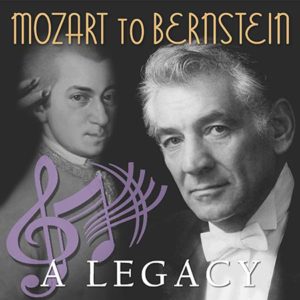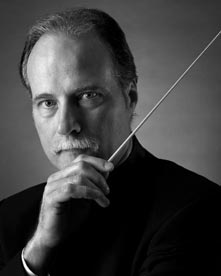
Concert 1 October 11, 2018
A Musical Legacy – From Mozart to Bernstein
Overture to Candide
Leonard Bernstein
The Young Person’s Guide to the Orchestra
Benjamin Britten
Symphony No. 40 in G Minor
Wolfgang Amadeus Mozart
Sponsored by

R.R. Fitch–Estates, Fine Arts, Antiques
Conductor’s Letter

Gene Dowdy, Conductor & Artistic Director
Dear Symphony of the Hills’ Friends,
Our first concert of the 2018-19 season is dedicated to the magnificent musical legacy that developed from Wolfgang Amadeus Mozart. Mozart, Beethoven, and Brahms are the pillars of Western European orchestral music. Their magnificent music is rare in that their relatively few works have stood the test of time. Composers of the 20th Century continued their legacy with a flurry of artistic excellence from all over the world. As more music is written, true masterworks become rare gems. 2018 is the 100th anniversary of the birth of Leonard Bernstein, the greatest American composer/conductor in our nation’s history. He was the first American conductor to receive worldwide acclaim. His works for the stage, such as his opera Candide, were his most successful compositions. Bernstein was also a passionate advocate and presenter of young people’s concerts. He introduced a generation of Americans to great composers and music. And, for the evening performance, you will be amazed at the wonderful vocal talent of local soprano Haley Dove Montoya, who will sing the fabulous opera “Glitter and be gay” from Bernstein’s Candide. As you may know, we perform our first concert this season two additional times for the youth of the Hill Country community. We are featuring another famous 20th century composer, the English composer Benjamin Britten. He, like Bernstein, was interested in presenting orchestral music to young people, and his work, The Young Person’s Guide to the Orchestra is played all over the world with various narrations. W.A. Mozart, arguably the most talented and certainly the most often performed composer in history, elevated the symphony genre to new technical and dramatic heights. This concert closes with one of Mozart’s greatest and latest symphonies, the Great G Minor Symphony number 40. I look forward to seeing you all in the beautiful Cailloux Theater on October 11.
With sincere appreciation for your support,
Gene Dowdy
Conductor & Artistic Director
Concert Notes
During this year, many orchestras throughout the world will celebrate the 100th birthday anniversary of Leonard Bernstein (Burn’-styne,) a composer and orchestra director of worldwide renown. Indeed, Bernstein is widely considered to be “one of the most prodigiously talented and successful musicians in American history.” Besides international popularity of the music that he composed, he achieved acclaim for his sterling leadership of the New York Philharmonic orchestra over several decades.
Overture to Candide
Leonard Bernstein (1918 – 1990)
Leonard Bernstein was both a brilliant, charismatic composer and a conductor with unique interpretive skills. He was a visionary, and an inclusive teacher who was totally accessible to all regardless of his fame. He was profoundly respected and loved all over the world, as demonstrated by the more than 2000 publicized international events this year to honor his legacy. His compositions were of wide-ranging genres between classical purism and the Broadway stage, most of which were wildly successful. He was a beloved fixture in major concert halls in the U. S. and Europe, as well as countries as culturally diverse as Japan, China, India, the Middle East and South America. His compositions were also wide ranging, exploring the psychic damage of WWII, the tragedy of gang warfare and the evils of bigotry. Candide was conceived in protest against 1950’s McCarthyism.
Leonard was born Louis Bernstein in Lawrence, Massachusetts, to Jennie (née Resnick) and Samuel Joseph Bernstein, a hairdressing supplies wholesaler and respected hair stylist who came to the U. S. from Rovno (now Ukraine). Early on, Louis was known to everyone as Lenny. (He changed his name officially to Leonard as a teenager.) The family in which Leonard grew up had no musical roots but ten-year old Lenny was drawn obsessively to his Aunt Clara’s piano. As per the usual situation, Samuel was vehemently opposed to his son’s musical pursuits, but Leonard was hooked. For all his misgivings, Samuel later conceded that his son was a genius. After graduation from Boston Latin School in 1935, Bernstein attended Harvard University, where he studied music. Bernstein’s main intellectual guide at Harvard was probably his aesthetics Professor David Prall, whose philosophy on the arts Bernstein shared for the rest of his life.
Although not particularly well received at its 1956 premiere, Bernstein’s Overture to Candide has now become a favorite. It is especially popular among major music schools as an ideal model to utilize in student development because of the quality of the music and the opportunities it affords to budding performers.
For those of you who didn’t take Philosophy in school or slept through the classes, Candide is an 18th century novella written by the French philosopher Voltaire. It was a satire taking the protagonist Candide from his sheltered, idyllic lifestyle through disillusionment and despair during which he witnesses great hardship in the world. Even after being banished from his homeland, captured by Bulgarians, beaten and left for dead by the Spanish Inquisition, robbed of everything he owns, and torn repeatedly from the woman he loves, Candide still clings to the philosophy that everything is for the best in this, “the best of all possible worlds.” Voltaire allegorically ridicules religion, theologians, governments, armies, philosophies, and philosophers as the story unfolds. One might wonder how anyone could make an overture from that. Here’s the story:
The play Candide, as originally conceived by Lillian Hellman, was greatly admired by Bernstein, who was inspired to write the overture for it. After a successful first concert performance in 1957 (by the New York Philharmonic led by Bernstein,) it quickly became popular and was performed by nearly 100 other orchestras within the next two years.
The overture is peppy and certainly reflective of a joyful mood. Much of the music is written in time signatures such as 6/4 and 3/2, which are combined with other tempos in a rapid, regular switching of the beat. While many orchestrations of the overture exist, in its current most popular form it incorporates changes made by Bernstein in 1989. It has become one of the most frequently performed orchestral compositions by a 20th century American composer.
The Young Person’s Guide to the Orchestra
Benjamin Britten (1913 – 1976)
Born in Suffolk, England, the son of a dentist, Benjamin Britten exhibited musical talent at an early age. After finishing his studies at the Royal College of Music, Britten came to public attention with the a cappella choral work A Boy was Born in 1934. Over the next 3 decades he wrote 14 operas, establishing himself as a notable 20th-century composer in that genre. He wrote several large-scale operas for important London theaters and “chamber operas” for performance in venues of modest size. Among the best known of these is The Turn of the Screw (1954). Recurring themes in Britten’s operas reflect the struggle of an outsider against a hostile society and the corruption of innocence.
Britten’s works range from orchestral- to choral-, solo vocal-, chamber- and instrumental- compositions as well as film scores. He had a special interest in writing music for children and amateur performers. Among Britten’s best-known orchestral works is The Young Person’s Guide to the Orchestra (1945). This composition, based on a theme by Purcell, showcases the orchestra’s individual sections and groups; it gained widespread popularity from the outset. Critics have called the work “exuberant and uncomplicated music, scored with clarity and vigor’” and “a brilliant educational exercise.” It’s perfect for the Children’s Concerts which were performed by the SoH yesterday for all the 3rd and 4th grade students in Kerrville and surrounding communities
Symphony No. 40 in G Minor
Wolfgang Amadeus Mozart (1756 – 1791)
Born to a musical family in Salzburg, Mozart, while still an infant, demonstrated an extraordinary aptitude for music composition and performance. Already competent on keyboard and violin at age five, he composed and performed before European royalty at that age under the rigorous supervision of Leopold Mozart, his father. Such performances continued through Wolfgang’s formative years and were an important source of family income. At age 17, Mozart was engaged as a musician at the Salzburg court.
Mozart was a prolific composer, having been credited with over 600 works, many acknowledged as superlative examples of symphonic, concertante, chamber, operatic, and choral music. He wrote 41 symphonies, the first when he was eight years old. It is probable that his father, who encouraged, guided and tutored Wolfgang, also transcribed most of his first symphony.
In the period 1782 – 1783, Mozart became acquainted with the works of Johann Sebastian Bach and George Frederik Handel from an acquaintance who owned many manuscripts of these Baroque masters. Mozart’s study of these scores inspired some of his compositions in the Baroque style and later influenced his musical expression as reflected in Die Zauberflöte (“The Magic Flute”) and the finale of Symphony No. 41.
Although a body of work by Mozart was in the Baroque style, the overarching traits of his music in modern parlance would be considered quintessential Classical, an evolution from the Baroque.
Mozart’s Symphony No. 40 is a monumental work, one that he probably never heard performed by an orchestra. This work has elicited varying interpretations from critics. Robert Schumann regarded it as possessing “Grecian lightness and grace.” A most common perception today is that the symphony is tragic in tone and intensely emotional; it has been called “a work of passion, violence, and grief”. Although interpretations differ, the symphony is unquestionably one of Mozart’s most greatly admired works, and is frequently performed and recorded. Beethoven knew the symphony well, copying out 29 bars from the score in one of his sketchbooks, which also appear amid the sketches for Beethoven’s Fifth Symphony.
The cause of Mozart’s death has attained mythological status, with plenty of conjecture. The official record has it as “severe miliary fever”, because of a rash looking like millet seed he developed shortly before his death. Researchers have posited at least 118 causes of death; the most recent conjecture reported (in National Geographic last year) is that he had a streptococcal infection that almost certainly resulted in cardiac events and potential kidney failure.

